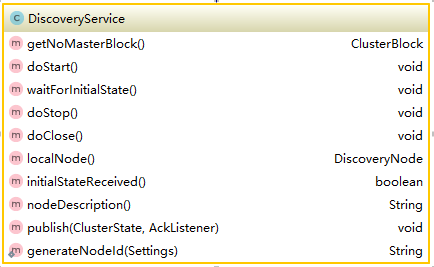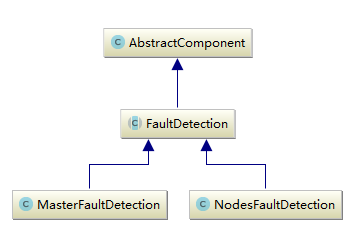前言
elasticsearch cluster实现了自己发现机制zen。Discovery功能主要包括以下几部分内容:master选举,master错误探测,集群中其它节点探测,单播多播ping。本篇会首先概述以下Discovery这一部分的功能,然后介绍节点检测。其它内容会在接下来介绍。
Discovery模块的概述
discovery是可配式模块,官方支持亚马逊的Azure discovery,Google Compute Engine,EC2 Discovery三种发现机制,根据插件规则完全可以自己实现其它的发现机制。整个模块通过实现guice的DiscoveryModule对外提供模块的注册和启动, 默认使用zen discovery。发现模块对外接口为DiscoveryService,它的方法如下所示:

它本质上是discovery的一个代理,所有的功能最终都是由所绑定的discovery所实现的。节点启动时通过DiscoveryModule获取DiscoveryService,然后启动DiscoveryService,DiscoveryService启动绑定的Discovery,整个功能模块就完成了加载和启动。这也是elasticsearch所有模块的实现方式,通过module对外提供绑定和获取,通过service接口对外提供模块的功能,在后面的分析中会经常遇到。
cluster节点探测
接下来分析cluster的一个重要功能就是节点探测。cluster中不能没有master节点,因此集群中所有节点都要周期探测master节点,一旦无法检测到,将会进行master选举。同时作为master,对于节点变动也要时刻关注,因此它需要周期性探测集群中所有节点,确保及时剔除已经宕机的节点。这种相互间的心跳检测就是cluster的faultdetection。下图是faultdetection的继承关系:

有两种实现方式,分别是master探测集群中其它节点和其它节点对master节点的探测。
FaultDetection只要一个抽象方法handleTransportDisconnect,该方法在内部类FDConnectionListener中被调用。在elasticsearch中大量使用了listener的异步方式,异步可以极大提升系统性能。它的代码如下所示:
|
1
2
3
4
5
6
7
8
9
|
private class FDConnectionListener implements TransportConnectionListener { @Override public void onNodeConnected(DiscoveryNode node) { } @Override public void onNodeDisconnected(DiscoveryNode node) { handleTransportDisconnect(node); } } |
faultdetection启动时会注册相应的FDConnetionListener,当探测到节点丢失,会通过onNodeDisconnected方法回调对于的handleTransportDisconnect进行处理。
MasterFaultDetection的启动代码
|
1
2
3
4
5
6
7
8
9
10
11
12
13
14
15
16
17
18
19
20
|
private void innerStart(final DiscoveryNode masterNode) { this.masterNode = masterNode; this.retryCount = 0; this.notifiedMasterFailure.set(false); // 尝试连接master节点 try { transportService.connectToNode(masterNode); } catch (final Exception e) { // 连接失败通知masterNode失败 notifyMasterFailure(masterNode, "failed to perform initial connect [" + e.getMessage() + "]"); return; } //关闭之前的masterping,重启新的masterping if (masterPinger != null) { masterPinger.stop(); } this.masterPinger = new MasterPinger(); // 周期之后启动masterPing,这里并没有周期启动masterPing,只是设定了延迟时间。 threadPool.schedule(pingInterval, ThreadPool.Names.SAME, masterPinger); } |
代码有有详细注释,就不再过多解释。
master连接失败的逻辑
代码如下:
|
1
2
3
4
5
6
7
8
9
10
11
12
13
14
|
private void notifyMasterFailure(final DiscoveryNode masterNode, final String reason) { if (notifiedMasterFailure.compareAndSet(false, true)) { threadPool.generic().execute(new Runnable() { @Override public void run() { //通知所有listener master丢失 for (Listener listener : listeners) { listener.onMasterFailure(masterNode, reason); } } }); stop("master failure, " + reason); } } |
在ZenDiscovery中实现了listener.onMasterFailure接口。会进行master丢失的相关处理,在后面再分析。
MasterPing的关键代码
|
1
2
3
4
5
6
7
8
9
10
11
12
13
14
15
16
17
18
19
20
21
22
23
24
25
26
27
28
29
30
31
32
33
34
35
36
37
38
39
40
41
42
43
44
45
46
47
48
49
50
51
52
53
54
55
56
57
58
59
60
61
62
63
64
65
66
67
68
69
70
71
72
|
private class MasterPinger implements Runnable { private volatile boolean running = true; public void stop() { this.running = false; } @Override public void run() { if (!running) { // return and don't spawn... return; } final DiscoveryNode masterToPing = masterNode; final MasterPingRequest request = new MasterPingRequest(clusterService.localNode().id(), masterToPing.id(), clusterName); final TransportRequestOptions options = options().withType(TransportRequestOptions.Type.PING).withTimeout(pingRetryTimeout); transportService.sendRequest(masterToPing, MASTER_PING_ACTION_NAME, request, options, new BaseTransportResponseHandler<MasterPingResponseResponse>() { @Override public MasterPingResponseResponse newInstance() { return new MasterPingResponseResponse(); } @Override public void handleResponse(MasterPingResponseResponse response) { if (!running) { return; } // reset the counter, we got a good result MasterFaultDetection.this.retryCount = 0; // check if the master node did not get switched on us..., if it did, we simply return with no reschedule if (masterToPing.equals(MasterFaultDetection.this.masterNode())) { // 启动新的ping周期 threadPool.schedule(pingInterval, ThreadPool.Names.SAME, MasterPinger.this); } } @Override public void handleException(TransportException exp) { if (!running) { return; } synchronized (masterNodeMutex) { // check if the master node did not get switched on us... if (masterToPing.equals(MasterFaultDetection.this.masterNode())) { if (exp instanceof ConnectTransportException || exp.getCause() instanceof ConnectTransportException) { handleTransportDisconnect(masterToPing); return; } else if (exp.getCause() instanceof NoLongerMasterException) { logger.debug("[master] pinging a master {} that is no longer a master", masterNode); notifyMasterFailure(masterToPing, "no longer master"); return; } else if (exp.getCause() instanceof NotMasterException) { logger.debug("[master] pinging a master {} that is not the master", masterNode); notifyMasterFailure(masterToPing, "not master"); return; } else if (exp.getCause() instanceof NodeDoesNotExistOnMasterException) { logger.debug("[master] pinging a master {} but we do not exists on it, act as if its master failure", masterNode); notifyMasterFailure(masterToPing, "do not exists on master, act as master failure"); return; } int retryCount = ++MasterFaultDetection.this.retryCount; logger.trace("[master] failed to ping [{}], retry [{}] out of [{}]", exp, masterNode, retryCount, pingRetryCount); if (retryCount >= pingRetryCount) { logger.debug("[master] failed to ping [{}], tried [{}] times, each with maximum [{}] timeout", masterNode, pingRetryCount, pingRetryTimeout); // not good, failure notifyMasterFailure(masterToPing, "failed to ping, tried [" + pingRetryCount + "] times, each with maximum [" + pingRetryTimeout + "] timeout"); } else { // resend the request, not reschedule, rely on send timeout transportService.sendRequest(masterToPing, MASTER_PING_ACTION_NAME, request, options, this); } } } } ); } } |
MasterPing是一个线程,在innerStart的方法中没有设定周期启动masterping,但是masterping需要周期进行,这个秘密就在run 方法中,如果ping成功就会重启一个新的ping。这样既保证了ping线程的唯一性同时也保证了ping的顺序和间隔。
ping的方式跟之前一样是也是通过transport发送一个masterpingrequest,进行一个连接。节点收到该请求后,如果已不再是master会抛出NotMasterException,状态更新出差会抛出其它异常,异常会通过。否则会正常响应notifyMasterFailure方法处理跟启动逻辑一样。
对于网络问题导致的无响应情况,会调用handleTransportDisconnect(masterToPing)方法处理。masterfaultDetection对该方法的实现如下:
|
1
2
3
4
5
6
7
8
9
10
11
12
13
14
15
16
17
18
19
20
21
22
23
24
25
26
27
28
29
30
31
|
protected void handleTransportDisconnect(DiscoveryNode node) { //这里需要同步 synchronized (masterNodeMutex) { //master 已经换成其它节点,就没必要再连接 if (!node.equals(this.masterNode)) { return; } if (connectOnNetworkDisconnect) { try { //尝试再次连接 transportService.connectToNode(node); // if all is well, make sure we restart the pinger if (masterPinger != null) { masterPinger.stop(); } //连接成功启动新的masterping this.masterPinger = new MasterPinger(); // we use schedule with a 0 time value to run the pinger on the pool as it will run on later threadPool.schedule(TimeValue.timeValueMillis(0), ThreadPool.Names.SAME, masterPinger); } catch (Exception e) { //连接出现异常,启动master节点丢失通知 logger.trace("[master] [{}] transport disconnected (with verified connect)", masterNode); notifyMasterFailure(masterNode, "transport disconnected (with verified connect)"); } } else { //不需要重连,通知master丢失。 logger.trace("[master] [{}] transport disconnected", node); notifyMasterFailure(node, "transport disconnected"); } } } |
这就是masterfaultDetection的整个流程:启动中如果master丢失则通知节点丢失,否则在一定延迟(3s)后启动masterping,masterping线程尝试连接master节点,如果master节点网络失联,尝试再次连接。master节点收到masterpingrequest后首先看一下自己还是不是master,如果不是则抛出异常,否则正常回应。节点如果收到响应是异常则启动master丢失通知,否则此次ping结束。在一定延迟后启动新的masterping线程。
NodeFaultDetection的逻辑跟实现上跟MasterFualtDetetion相似,区别主要在于ping异常处理上。当某个节点出现异常或者没有响应时,会启动节点丢失机制,只是受到通知后的处理逻辑不通。就不再详细分析,有兴趣可以参考具体代码,希望大家以后多多支持服务器之家!
原文链接:https://www.cnblogs.com/zziawanblog/p/6533731.html
















